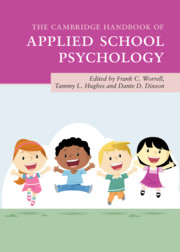Book contents
- The Cambridge Handbook of Applied School Psychology
- The Cambridge Handbook of Applied School Psychology
- Copyright page
- Contents
- Contributors
- Contributor Biographies
- Acknowledgments
- 1 Broadening the Focus of School Psychology Practice
- Part I Individual-Level Academic Interventions
- Part II Teacher- and System-Level Interventions
- Part III Interventions from Educational and Social/Personality Psychology
- Part IV Behavioral and Social-Emotional Interventions
- Part V Health and Pediatric Interventions
- Part VI Family Connections and Life Transitions
- Part VII Special Populations
- Part VIII Conclusion
- 37 Rising to the Challenge: A School Psychology for All Students
- Index
- References
37 - Rising to the Challenge: A School Psychology for All Students
from Part VIII - Conclusion
Published online by Cambridge University Press: 18 September 2020
- The Cambridge Handbook of Applied School Psychology
- The Cambridge Handbook of Applied School Psychology
- Copyright page
- Contents
- Contributors
- Contributor Biographies
- Acknowledgments
- 1 Broadening the Focus of School Psychology Practice
- Part I Individual-Level Academic Interventions
- Part II Teacher- and System-Level Interventions
- Part III Interventions from Educational and Social/Personality Psychology
- Part IV Behavioral and Social-Emotional Interventions
- Part V Health and Pediatric Interventions
- Part VI Family Connections and Life Transitions
- Part VII Special Populations
- Part VIII Conclusion
- 37 Rising to the Challenge: A School Psychology for All Students
- Index
- References
Summary
In this chapter, we begin with an overview of the achievement gap, highlighting differences by gender, ethnicity/race, and socioeconomic status. We then discuss the complexities of dealing with culture, ethnicity, and race in school psychology and review several studies that have used these constructs. A brief overview of the association between mental well-being and achievement outcomes is next, followed by a brief discussion of grit as a cautionary tale. We conclude with some general recommendations for the field.
- Type
- Chapter
- Information
- The Cambridge Handbook of Applied School Psychology , pp. 657 - 671Publisher: Cambridge University PressPrint publication year: 2020



